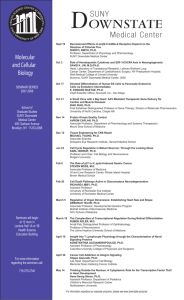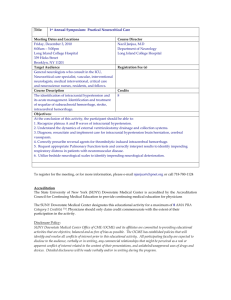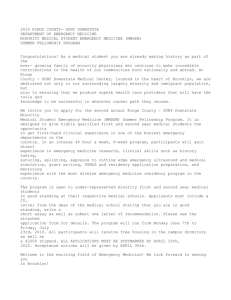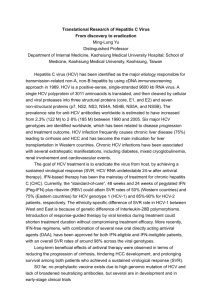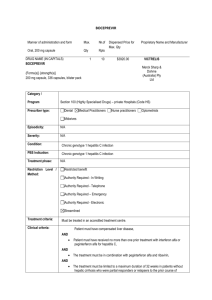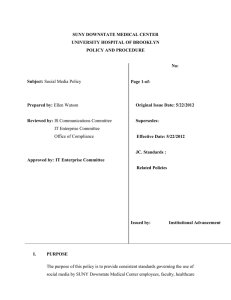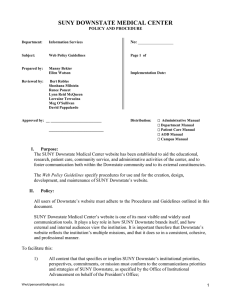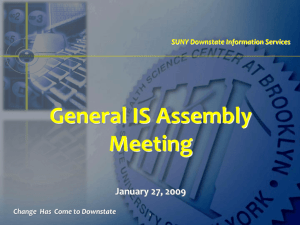SUNY Downstate press release - Healthcare Policy & Research
advertisement
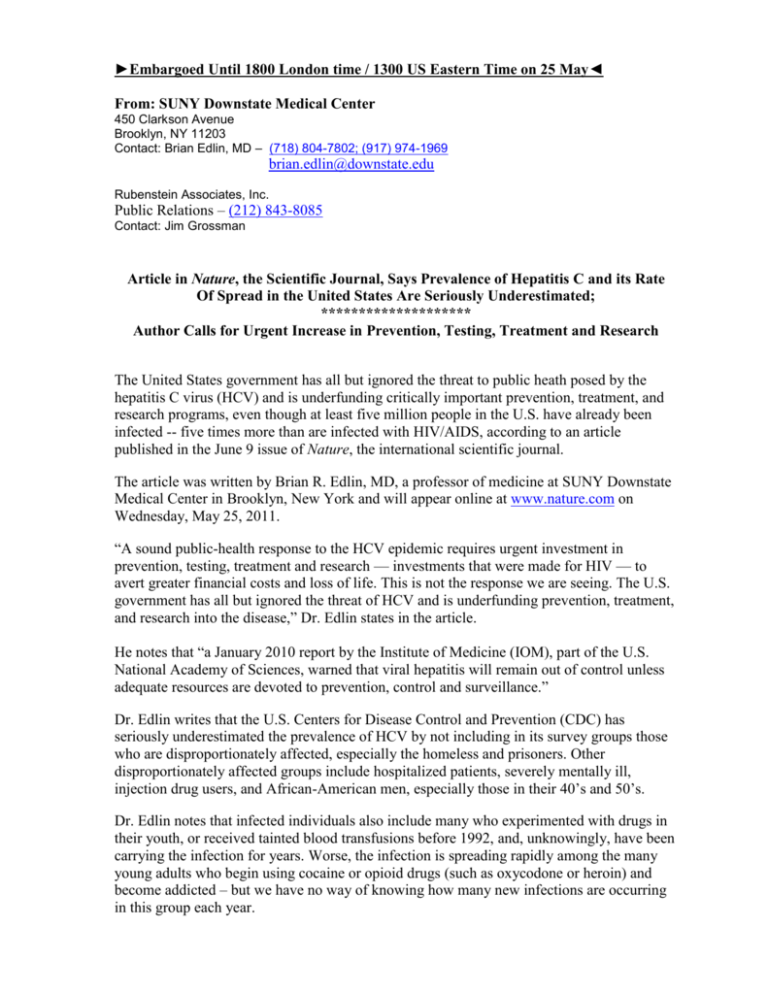
►Embargoed Until 1800 London time / 1300 US Eastern Time on 25 May◄ From: SUNY Downstate Medical Center 450 Clarkson Avenue Brooklyn, NY 11203 Contact: Brian Edlin, MD – (718) 804-7802; (917) 974-1969 brian.edlin@downstate.edu Rubenstein Associates, Inc. Public Relations – (212) 843-8085 Contact: Jim Grossman Article in Nature, the Scientific Journal, Says Prevalence of Hepatitis C and its Rate Of Spread in the United States Are Seriously Underestimated; ******************** Author Calls for Urgent Increase in Prevention, Testing, Treatment and Research The United States government has all but ignored the threat to public heath posed by the hepatitis C virus (HCV) and is underfunding critically important prevention, treatment, and research programs, even though at least five million people in the U.S. have already been infected -- five times more than are infected with HIV/AIDS, according to an article published in the June 9 issue of Nature, the international scientific journal. The article was written by Brian R. Edlin, MD, a professor of medicine at SUNY Downstate Medical Center in Brooklyn, New York and will appear online at www.nature.com on Wednesday, May 25, 2011. “A sound public-health response to the HCV epidemic requires urgent investment in prevention, testing, treatment and research — investments that were made for HIV — to avert greater financial costs and loss of life. This is not the response we are seeing. The U.S. government has all but ignored the threat of HCV and is underfunding prevention, treatment, and research into the disease,” Dr. Edlin states in the article. He notes that “a January 2010 report by the Institute of Medicine (IOM), part of the U.S. National Academy of Sciences, warned that viral hepatitis will remain out of control unless adequate resources are devoted to prevention, control and surveillance.” Dr. Edlin writes that the U.S. Centers for Disease Control and Prevention (CDC) has seriously underestimated the prevalence of HCV by not including in its survey groups those who are disproportionately affected, especially the homeless and prisoners. Other disproportionately affected groups include hospitalized patients, severely mentally ill, injection drug users, and African-American men, especially those in their 40’s and 50’s. Dr. Edlin notes that infected individuals also include many who experimented with drugs in their youth, or received tainted blood transfusions before 1992, and, unknowingly, have been carrying the infection for years. Worse, the infection is spreading rapidly among the many young adults who begin using cocaine or opioid drugs (such as oxycodone or heroin) and become addicted – but we have no way of knowing how many new infections are occurring in this group each year. -Continued-2“The United States launched a vibrant response to the HIV/AIDS epidemic and has taken great strides in disease surveillance, prevention, care and treatment. This was only made possible by investing in research and services in these areas. Nothing less will mitigate the extraordinary cost to healthcare and the toll that viral hepatitis could take on public health and ultimately people’s lives,” Dr. Edlin’s articles states. He makes the following recommendations: --Provide needle-exchange facilities, syringe access, community-based outreach and education, community-based services, testing and counseling, and linkage to care and substance-use treatment nationally. --Provide HCV testing to populations with a high HCV prevalence and wherever HIV testing is available. --Provide multidisciplinary services, comprehensive and continuing primary and specialty medical care, substance-use treatment, mental health care, case management, support services, and provider education and training nationally. --Provide HCV prevention, testing and treatment services in correctional institutions. --Develop and implement surveillance systems for disenfranchised populations --Prioritize the development of better interventions so that prevention, testing and care can be more effectively and efficiently provided to those who need it. *Hepatitis C is an infectious disease affecting the liver. The infection is often asymptomatic, but once established, chronic infection can progress to scarring of the liver (fibrosis) and advanced scarring (cirrhosis), which is generally apparent after many years. In some cases, those with cirrhosis will go on to develop liver failure or other complications of cirrhosis, including liver cancer and/ or life threatening damage to esophageal and gastric veins. SUNY Downstate Medical Center, founded in 1860, was the first medical school in the United States to bring teaching out of the lecture hall and to the patient’s bedside. A center of innovation and excellence in research and clinical service delivery, SUNY Downstate Medical Center comprises a College of Medicine, Colleges of Nursing and Health Related Professions, a School of Graduate Studies, a School of Public Health, University Hospital of Brooklyn, and an Advanced Biotechnology Park and Biotechnology Incubator. SUNY Downstate ranks ninth nationally in the number of alumni who are on the faculty of American medical schools. More physicians practicing in New York City have graduated from SUNY Downstate than from any other medical school. ###
